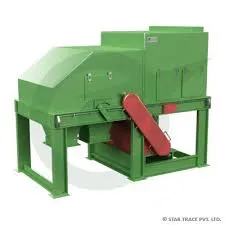

nov . 07, 2024 08:44 Back to list
Understanding Eddy Current Separators A Comprehensive Overview
Eddy current separators are critical machines employed in the recycling and waste management industries for their ability to efficiently separate non-ferrous metals from other materials. The foundational principle behind eddy current separation is the generation of eddy currents when conductive materials pass through a changing magnetic field. This article delves into the working mechanism of eddy current separators, their applications, and advantages.
Working Mechanism
The core of an eddy current separator consists of a belt conveyor, a rotor, and a magnetic field. As materials are fed onto the conveyor belt, they pass beneath the rotating magnetic rotor. This rotor has permanent magnets that create a rapidly alternating magnetic field. When a non-ferrous metal enters this field, it experiences a change in magnetic flux, resulting in the induction of eddy currents within the metal itself. These currents generate their own magnetic field, which interacts with the original magnetic field created by the rotor.
Due to this interaction, the non-ferrous metals (such as aluminum, copper, and brass) are propelled away from non-metallic residue and other ferrous materials, which do not generate significant eddy currents. The separation process occurs along the conveyor belt, where the different materials are efficiently sorted into designated collection areas.
Key Components
1. Conveyor Belt This is the platform on which the materials are fed for separation. Its design and speed can be adjusted based on the volume and type of materials being processed.
2. Eddy Current Rotor The rotor is a critical component, designed with permanent magnets that create a pulsed magnetic field. The configuration and speed of the rotor play a significant role in the efficiency of separation.
3. Material Feeder This system evenly distributes materials onto the conveyor belt to ensure optimal processing and avoid blockages.
4. Controls and Sensors Advanced eddy current separators are equipped with controls and sensors that monitor the material flow, adjusting the belt speed and rotor operation dynamically to enhance separation efficiency.
Applications
Eddy current separators are widely used across various industries, the most notable being

- Recycling Facilities They are instrumental in extracting valuable metals from mixed waste streams, ensuring materials like aluminum and copper are reclaimed for recycling
.- Waste Management These separators help in waste sorting, allowing for efficient landfill diversion by separating metals from non-metallic waste.
- Mining and Mineral Processing In these industries, they aid in recovering valuable metal ores during mineral extraction processes.
Advantages
The advantages of using eddy current separators are numerous
- High Efficiency The design allows for quick processing, with high separation rates for non-ferrous metals.
- Reduction of Contamination By effectively separating metals from waste, they reduce contamination and improve the quality of recycled materials.
- Low Operating Costs Though the initial investment may be high, the operational costs remain low due to low energy consumption and minimal maintenance requirements.
- Versatility Eddy current separators can handle a wide range of materials, making them suitable for various applications and adaptable to different operational setups.
Conclusion
Eddy current separators are a vital technology in modern recycling and waste management efforts, promoting sustainability by maximizing the recovery of valuable metals from waste streams. Their innovative design leverages the principles of electromagnetism to efficiently target and separate non-ferrous metals, contributing significantly to reducing landfill waste and conserving natural resources. As industries continue to focus on circular economy principles, the use and development of eddy current separators will only increase, driving improvements in material recovery rates and operational efficiency. Understanding their functioning and potential can lead to better implementation strategies and improved environmental outcomes.
Latest news
Troubleshooting Common Eddy Separator Problems
NewsJul.04,2025
The Role of Metal Recycling Plants in Circular Economy
NewsJul.04,2025
The Impact of Recycling Line Pickers on Waste Management Costs
NewsJul.04,2025
Safety Features Every Metal Shredder Should Have
NewsJul.04,2025
How Industrial Shredders Improve Waste Management Systems
NewsJul.04,2025
How Cable Granulators Contribute to Sustainable Recycling
NewsJul.04,2025